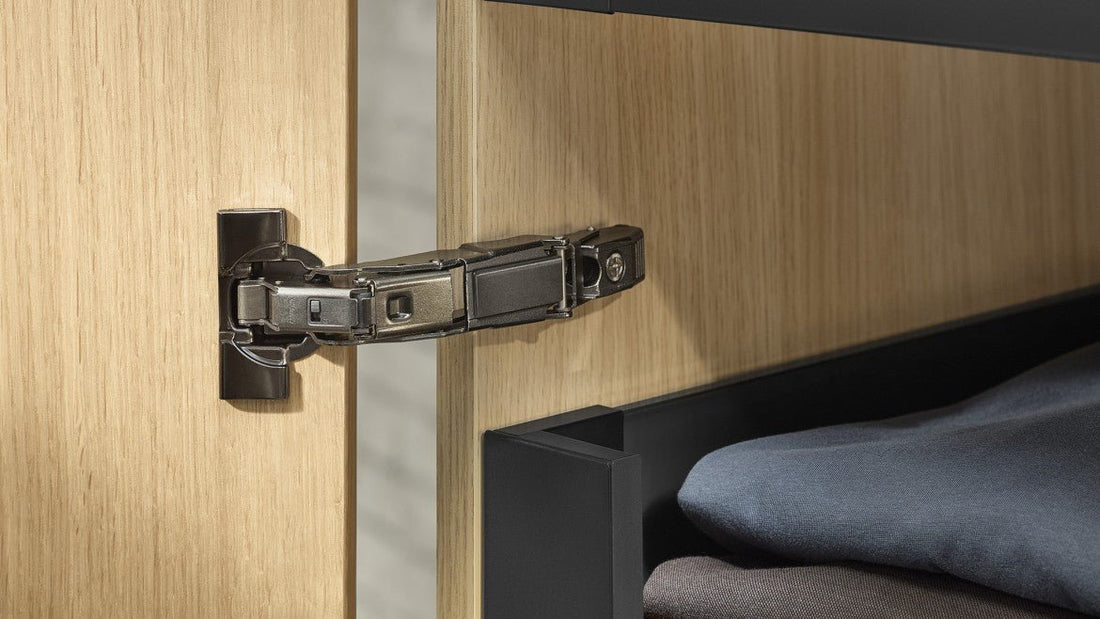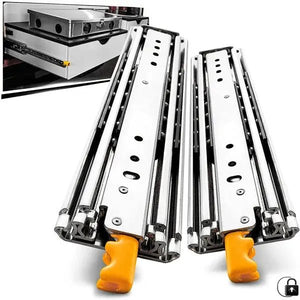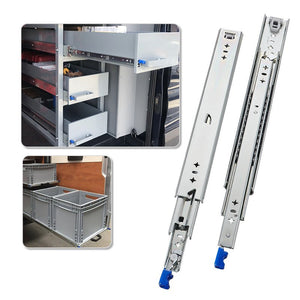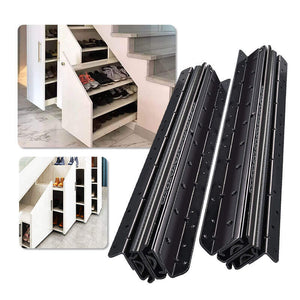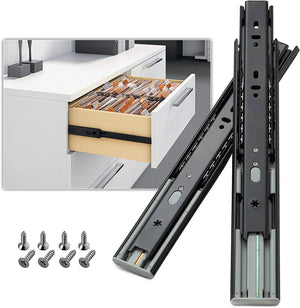I. Introduction
In the realm of door fixtures, heavy-duty hinges play a crucial role in providing robust support, ensuring smooth functionality, and enhancing the overall durability of doors. Whether it's for residential or commercial purposes, the proper installation of heavy-duty hinges is essential for optimal performance and longevity. This article delves into the art of heavy-duty hinge installation, guiding you through the process and addressing common concerns.
Heavy-duty hinges are engineered to withstand greater weights and stress compared to regular hinges. They are indispensable in scenarios where sturdiness and reliability are paramount, such as heavy doors, gates, or industrial applications. Understanding the importance of heavy-duty hinges sets the stage for recognizing the need for precise installation.
Customers often express concerns related to heavy-duty hinge installation. These concerns may range from the complexity of the process to doubts about whether the installed hinges can truly handle heavy loads. This article aims to address these concerns head-on, providing clarity and instilling confidence in readers who might be undertaking this task for the first time.
As we unravel the intricacies of heavy-duty hinge installation, the subsequent sections will guide you through the essential tools, pre-installation preparations, and a step-by-step guide. Stay tuned for a comprehensive exploration of the art and science behind achieving a seamless heavy-duty hinge installation.

II. Essential Tools and Materials
When venturing into the realm of heavy-duty hinge installation, having the right tools and materials at your disposal is akin to having a reliable compass on a journey. This section will delve into the key components that lay the foundation for a successful installation.
Tools for Precision
To achieve precision in heavy-duty hinge installation, certain tools are indispensable. These include:
1. Power Drill with Various Bits
A power drill is a versatile tool that aids in creating precise holes for screws. Different bits cater to specific needs, ensuring compatibility with various hinge types.
2. Chisels and Woodworking Tools
Chisels play a crucial role in fine-tuning the recesses for hinges. Woodworking tools, such as a mallet and carving tools, assist in carving out precise spaces for hinge placement.
3. Measuring Tools: Tape Measure, Square, and Level
Accurate measurements are the backbone of successful hinge installation. A tape measure ensures proper dimensions, while a square and level guarantee alignment and balance.
4. Screwdriver Set
A comprehensive set of screwdrivers, including Phillips and flathead varieties, is essential for securing hinges firmly in place.

Quality Materials for Durability
Equally vital as the tools are the materials selected for the installation. Quality materials contribute to the longevity and effectiveness of heavy-duty hinges. These include:
Choosing the right heavy-duty hinges based on the door's weight and size is paramount. The hinges should be crafted from durable materials such as stainless steel for longevity.
2. Screws and Fasteners
Opt for high-quality screws and fasteners that are corrosion-resistant. These ensure a secure and long-lasting bond between the hinges and the door or frame.
3. Wood Glue
Wood glue reinforces the connection between the hinge and the wood, adding an extra layer of stability. It is particularly useful when dealing with wooden doors.
4. Wood Filler
For any unintentional gaps or voids, wood filler comes in handy. It provides a seamless finish, enhancing both aesthetics and structural integrity.
Ensuring you have the right tools and materials sets the stage for a smooth heavy-duty hinge installation process. In the upcoming section, we will explore the step-by-step guide to master the art of installing heavy-duty hinges.

III. Step-by-Step Installation Guide
In this comprehensive guide, we will walk you through the step-by-step process of installing heavy-duty hinges. Follow these instructions carefully to ensure a secure and reliable installation that stands the test of time.
Gather Your Tools
1. Essential Tools for the Job
Before starting the installation, ensure you have the necessary tools:
- Power drill
- Chisels
- Measuring tape
- Screwdriver
- Pencil
Preparing the Door and Frame
1. Marking Hinge Positions
Using a pencil and measuring tape, mark the positions for the hinges on both the door and the frame. Ensure accurate placement to guarantee proper alignment.
2. Creating Mortises
With a chisel, carefully create mortises for the hinges on both the door and the frame. Take your time to achieve clean and precise cuts.

Installing Hinges on the Door
1. Attaching Hinges
Secure the hinges onto the door using the provided screws. Ensure a tight fit, and double-check the alignment to prevent future issues.
2. Testing Movement
Open and close the door multiple times to confirm smooth movement. Adjust the hinge position if necessary for optimal functionality.
Attaching Hinges to the Frame
1. Aligning with Door Hinges
Position the frame hinges to align perfectly with the hinges on the door. Accuracy at this stage is crucial for the door to function seamlessly.
2. Securing Frame Hinges
Attach the frame hinges securely using the screws provided. Confirm that the door opens and closes smoothly without any resistance.

Fine-Tuning for Precision
1. Checking Alignment
Verify that the door is perfectly aligned with the frame. Make any necessary adjustments to achieve precise alignment.
2. Tightening Screws
Ensure all screws are tightened securely to prevent loosening over time. Regularly inspect the hinges and re-tighten screws if needed.
Final Testing
1. Full Range of Motion
Test the door's full range of motion to guarantee that it opens and closes effortlessly. Address any issues immediately to avoid long-term damage.
2. Load-Bearing Test
If applicable, conduct a load-bearing test to ensure the heavy-duty hinges can support the weight of the door without strain.
By following this step-by-step installation guide, you'll be well on your way to achieving a flawless heavy-duty hinge installation. The next section will delve into the benefits of upgrading to heavy-duty hinges for various applications.

IV. Maintenance Tips for Heavy Duty Hinges
Proper maintenance is crucial for ensuring the longevity and optimal functionality of heavy-duty hinges. This section provides valuable tips on how to maintain and care for your heavy-duty hinges, preserving their performance over time.
Regular Inspection and Cleaning
1. Inspect for Wear and Tear
Periodically inspect the hinges for any signs of wear, corrosion, or damage. Pay attention to areas where the hinge components meet and move against each other.
2. Clean Dirt and Debris
Keep the hinges clean from accumulated dirt and debris. Use a soft brush or cloth to remove any particles that might interfere with the hinge movement.
Lubrication for Smooth Operation
1. Choose the Right Lubricant
Select a high-quality lubricant suitable for heavy-duty hinges. Silicone-based or lithium grease works well for reducing friction and ensuring smooth operation.
2. Apply Lubricant Regularly
Apply the chosen lubricant to the hinge pivot points and moving parts regularly. This helps prevent friction, reduces wear, and ensures the hinges operate seamlessly.

Tighten Loose Screws
1. Check Screw Tightness
Over time, screws may become loose due to constant movement. Periodically check and tighten any loose screws to maintain the stability of the hinge.
2. Use Threadlocker if Necessary
For added security, consider using a threadlocker on the screws. This prevents them from loosening due to vibrations or frequent use.
Addressing Corrosion Issues
1. Remove Rust Promptly
If you notice any signs of rust or corrosion, address them promptly. Use a rust dissolver and a wire brush to remove rust, then apply a rust-resistant coating.
2. Consider Corrosion-Resistant Hinges
When replacing or upgrading hinges, consider investing in corrosion-resistant options for enhanced durability, especially in environments prone to moisture.
Adjusting Hinge Alignment
1. Check Door Alignment
Periodically check the alignment of the door with the frame. If misalignment occurs, adjust the hinge position to ensure a proper fit.
2. Use Shims for Alignment
If needed, use shims to adjust the alignment. This ensures the door closes securely and prevents unnecessary stress on the hinges.
Professional Inspection
1. Schedule Professional Inspection
Consider scheduling regular professional inspections, especially for heavy-duty hinges supporting substantial loads. Professionals can identify issues early and provide expert solutions.
2. Replace Worn Components
If professionals identify worn components during inspections, follow their recommendations for timely replacement. This prevents further damage and ensures the hinge's continued reliability.
By incorporating these maintenance tips into your routine, you can extend the lifespan of your heavy-duty hinges and maintain their smooth functionality. The next section will address frequently asked questions, providing additional insights for users.

V. Conclusion
In conclusion, mastering the nuances of heavy-duty hinges involves understanding their types, benefits, installation processes, and maintenance requirements. These robust components play a pivotal role in various applications, from industrial settings to residential projects, providing durability and reliability.
Embracing the diversity of heavy-duty hinges allows you to tailor your choice to the specific demands of your project. Whether you opt for concealed hinges, butt hinges, or strap hinges, each type brings unique advantages, contributing to the seamless operation and longevity of doors, gates, and cabinets.
For complex projects or applications with significant loads, consider seeking professional guidance. Experts can provide tailored recommendations, ensuring the heavy-duty hinges meet and exceed performance expectations.
In essence, heavy-duty hinges transcend their functional role and become integral elements in the design and functionality of doors, gates, and cabinets. By navigating the landscape of heavy-duty hinges with knowledge, precision, and a commitment to maintenance, you elevate your hinge experience and ensure lasting success in your projects.
Thank you for accompanying us on this journey through the world of heavy-duty hinges.

